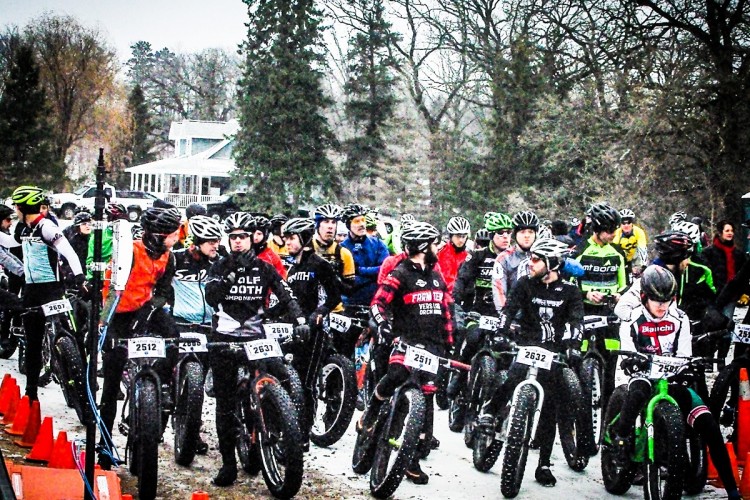In case you haven’t noticed, fat biking is now “a thing.“ It is arguably the most explosive niche of modern mountain biking at the moment, and new technologies are being developed faster than ever before. There are several things anyone can do to any fat bike to improve performance, but one thing that people consistently ask about is whether or not they should set their tires up tubeless.
- Is it worth the cost?
- Is it safe?
- Can tubeless be run year-round even in sub-zero temperatures?
All valid questions that only you can answer based on the kind of riding you do, but most riders I know agree that you’d be crazy not to convert.

First of all, converting a fat bike tire to tubeless has a lot of benefits in every season, on both snow and dry dirt. Aside from the ability to run low pressures and squeeze out even more traction from a 4- or 5-inch-wide tire, it saves a tremendous amount of weight. The average fat bike tube weighs 450-500 grams, a total of 900-1000 grams for both (not including sealant). Converting your fat bike to tubeless saves up to a kilogram, or 2.2 pounds, of rotational mass!
Secondly, shaving weight on your tires will improve acceleration, roll-ability, and cornering in both snow and dirt as long as you find the correct pressure to run them at.
Lastly, you won’t risk a pinch flat, and think of all the money you’ll save on tubes!
There are several things you need to keep in mind if you want to convert your fat bike to tubeless:
1. Most rims are not “tubeless ready” but can be converted easily.
Some of the newer, expensive carbon rims, such as the Borealis Carbondale rims, Whiskey Carbon Rims, or HED Big Deal rims, are designed to be tubeless ready, but they are very expensive. A few aluminum rims are starting to come to market as well, but converting a standard rim such as a Surly Rolling Darryl really only requires some gorilla tape, a valve stem, sealant, and a compressor. For less than $50 you can have the materials to convert.
Be sure to watch this helpful instructional video and do the conversion yourself:
2. When not riding on snow or ice, add sealant.
Because of the increased likelihood of puncture, is imperative that you run 6-8 ounces of sealant, such as Stan’s or Orange Seal, when riding dirt. This not only helps the tire seat on initial installation and maintain a bead, more importantly it retards the inevitability of a sudden blowout–which can result in catastrophic rim damage if you are rallying hard. Refreshing the sealant every 3-6 months is also recommended during warmer months, and expect occasional burping of sealant… especially if the bead gets dirty.

Should you run tubeless year-round? Sealant does not work well in really cold temperatures, but you can run tubeless on snow without sealant. Also consider that a lot of winter riders, especially in endurance races like the Arrowhead 135, prefer tubes for a variety of reasons. The risk of pinch flats are low, and no one wants to change a tire in sub-zero temperatures if you have a tubeless failure.
3. Carry a spare fat bike tube and a hand pump when you ride.
Carrying a spare is good advice no matter what tire size or bike you have. When fat bike tires get a leak, even with tubes, you’ll know it because they exhale a lot of air quickly. What you may not realize is that a standard CO2 cartridge will essentially be worthless if you get a flat because of the volume of a fat bike tire. Fat bike tubes are now readily available from several manufacturers, including Surly and Specialized, but many riders opt to use beefier downhill 26in tubes, like the Q-Tubes 2.4, which are durable, cheaper, and lighter.
4. Purchase a digital air pressure gauge.
Standard tire pumps are not generally accurate at pressures below 15 psi, and also lose their accuracy at any given pressure over the life of the pump. Investing in a quality analog or digital tire pressure gauge, which costs less than $25, is invaluable for all of your bikes.

Conclusion
Converting your fatty to tubeless makes a lot of sense for most riders. Most home mechanics can easily do this with the right tools and a little patience. If you do not feel comfortable converting them yourself, your local dealer should be able to do it for about $50 per wheel.
Before I converted to tubeless three seasons ago, I punctured four tubes in the first month I owned my first fat bike. I had my LBS convert them, which was a new idea at the time, and I’ve put over 350 miles on my rig with no problems. Even more importantly, I am able to run my tires as low as 3psi in snow to maximize traction, and only need around 6psi even on the gnarliest dry singletrack.
[see_also id=”52169″][/see_also]

Your turn: Have you converted your fat bike tires to tubeless? Did you run into any problems with the installation process?



















2 Comments
Feb 27, 2015
Jan 15, 2016